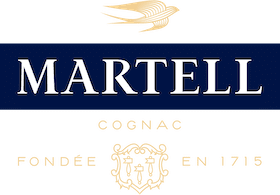
Craftsmanship
TerroirTerroir
The grape-growing area of Cognac is located in the Charente region of France, near the Atlantic coast. The Cognac region itself is divided into six vineyard areas, or crus. This white, sun-blessed land has a mild ocean climate that encourages optimum growth of the region’s predominant grape variety, Ugni Blanc. It is the richness and complexity of the different crus that give cognac its famous characteristics: smoothness and elegance with notes of candied fruit, soft spices and flowers.

Terroir
When Jean Martell founded Maison Martell, he already had his eye on the Borderies, the smallest and rarest of cognac crus. The grapes that grow in the silica-clay soils of the Borderies give its eaux-de-vie distinctive floral aromas and an exceptional smoothness. It is this unique terroir that lends the finest Martell cognacs their hallmark elegance and subtlety.
DistillationDistillation
Bubbling away in copper stills, clear white wine made from grapes harvested in the Cognac region begins its transformation into eau-de-vie. This is the distillation process.
To ensure authentic flavour, traditional copper pot stills are still used to heat the wine. As it simmers away, the vapour rises up through the still head, passing through the swan neck and into the coil, where it condenses to form a clear, warm liquor. Of the great cognac houses, Martell is the only one to distil exclusively clear wines (from which all sediments and impurities have been removed), in order to produce exceptionally fine eaux-de-vie which reveal all the aromas of the grapes.

Transforming fruity wine into the perfect eau-de-vie is a highly delicate operation that requires the close attention of the Master Distiller and his team. The time and temperature of the distillation process must be controlled to perfection.
AgeingAgeing
In the darkness and silence of the Martell cellars, the eaux-de-vie gently rest. Days, months, years pass.
A beautiful transformation is taking place. Oak barrels, themselves a living material, provide the eau-de-vie with its structure and handsome amber colour, and help it develop the last stage of its aromatic personality.

Ageing
Maison Martell has always exclusively used barrels made of fine-grained oak – its special feature being that it transmits subtle, well-balanced aromas to the eaux-de-vie, lending them notes of vanilla, dried fruit, red fruit, chutney and flowers.
The oak used for Martell barrels comes from trees of the Tronçais style. This means that the oaks are planted close together, leaving less light for each sapling and slowing their growth rate. The result is fine-grained wood, so called because the rings representing growth are more compact. Barrels made from this type of oak give the eaux-de-vie aged within them a lighter and more delicate woody taste.
Ageing
Along with the choice of oak, the type of barrel used also greatly affects the flavour of the eaux-de-vie. If made with completely new wood, barrels impart a strong woody taste, whereas barrels that have previously held eaux-de-vie give a much subtler flavour.
A final, major taste element is ‘toasting’ – a process where the inside of the barrels is gently burnt to help release the complex flavours within the oak. This affects the taste – the more the barrels are burnt, the more prominent the woody notes. At Maison Martell, barrels are lightly toasted to preserve the inherent flavour of the eaux-de-vie.
BlendingBlending
A question of time… Some eaux-de-vie mature at two years (the minimum ageing period for cognac), while some develop at 20, others at 70. It is all down to the watchful eye of the Martell Cellar Master to decide when the eaux-de-vie have reached their full potential.
When the eaux-de-vie have matured, they are removed from the oak barrels and placed in glass demijohns. This stops the ageing process, keeping the eaux-de-vie in their perfectly matured state. At this point, the finest eaux-de-vie are stored in the Jean Martell cellar, where some attain a great age, biding their time until, perhaps centuries later, they are used to make the rarest of cognacs.

Blending
Each eau-de-vie has a unique character, shaped not only by the cru from which it originated, but also by the choices made during the ageing process, such as the type of oak barrel used and the length of time it was left to mature. Like a singular note in a complex symphony, the Cellar Master must know how to introduce and combine each tone to create a perfect harmony.
Blending
It is the blending process that gives cognac its inimitable, everlasting bouquet. During blending a complex palette of flavours stands before the Cellar Master, from which he must construct the personality of each product, while following the original recipe. His task is made even more complex since the eaux-de-vie naturally change slightly each year, depending on the climate and harvest.
Please do not share with anyone under 18. Drink responsibly.







